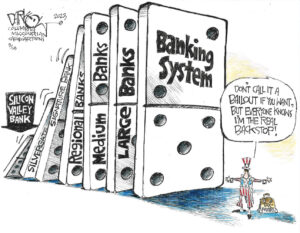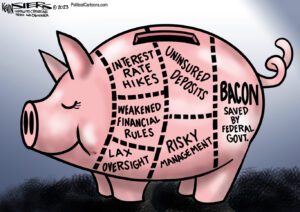Congress Sings the Bailout Blues
Want to know where the $350 billion banking bailout went and why it hasn't done a bit of good? Read, and weep over, this little-noticed report from the congressional panel set up to monitor the Treasury Department's distribution of our taxpayer funds.
Want to know where the $350 billion banking bailout went and why it hasn’t done a bit of good? Read, and weep over, this little-noticed report from the congressional panel set up to monitor the Treasury Department’s distribution of our taxpayer funds.
The money has done little to ease the credit crunch and has given no help to those facing foreclosure. Instead, it has been used to fatten the accounts of the very banks that got us into this mess. In the face of such devastating criticism of the Treasury Department by a panel set up by Congress to monitor the spending, our representatives went right ahead and allocated another $350 billion.
The executive summary of the Congressional Oversight Panel (COP) report follows. For the full report, click here.
EXECUTIVE SUMMARY
In its first report to Congress on December 10, 2008, the Congressional Oversight Panel (COP or the Panel) posed ten basic questions – in effect asking for an explanation of the U.S. Department of Treasury’s goals and methods for the Troubled Asset Relief Program (TARP). The Panel’s questions, in turn, included a number of subsidiary questions, which sought additional details from the Treasury. In total, the Panel sought responses to 45 separate questions about the execution of the authority granted to Treasury under the Emergency Economic Stabilization Act (EESA) and the $350 billion in taxpayer funds that has been “effectively allocated” under that program. On December 30, 2008, Treasury responded to the Panel with a 13-page letter. While the letter provided responses to some of the Panel’s questions and shed light on Treasury’s decision-making process, it did not provide complete answers to several of the questions and failed to address a number of the questions at all. To gain a more complete understanding of what Treasury is doing and why, the Panel asks Treasury to provide additional information clarifying its earlier responses.
In order to exercise its legally-mandated oversight functions, the Panel has initiated a number of fact-finding efforts and independent investigations that will be the subject of future reports. But the Panel’s independent work does not eliminate the need for Treasury to respond to the Panel’s questions. Some of these questions can be answered only by Treasury (e.g., Treasury’s strategic plans) and others seek to clarify what appear to be significant gaps in Treasury’s monitoring of the use of taxpayer money (e.g., asking financial institutions to account for what they have done with taxpayer funds).
To ease the burden on Treasury and to make it clear precisely which questions remain to be answered, the Panel has constructed a grid with its original questions and Treasury’s responses. Although many questions remain outstanding, the Panel highlights four specific areas that it believes deserve special attention:
(1) Bank Accountability. The Panel still does not know what the banks are doing with taxpayer money. Treasury places substantial emphasis in its December 30 letter on the importance of restoring confidence in the marketplace. So long as investors and customers are uncertain about how taxpayer funds are being used, they question both the health and the sound management of all financial institutions. The recent refusal of certain private financial institutions to provide any accounting of how they are using taxpayer money undermines public confidence. For Treasury to advance funds to these institutions without requiring more transparency further erodes the very confidence Treasury seeks to restore. Finally, the recent loans extended by Treasury to the auto industry, with their detailed conditions affecting every aspect of the management of those businesses, highlights the absence of any such conditions in the vast majority of TARP transactions. EESA does not require recipients of TARP funds to make reports on the use of funds. However, it is within Treasury’s authority to make such reports a condition of receiving funding, to establish benchmarks for TARP recipient conduct, or to have formal procedures for voluntary reporting by TARP recipient institutions or formal guidelines on the use of funds. The adoption of any one of these options would further the purposes of helping build and restore the confidence of taxpayers, investors, and policy makers.(2) Transparency and Asset Evaluation. The need for transparency is closely related to the issue of accountability. The confidence that Treasury seeks can be restored only when information is completely transparent and reliable. Currently, Treasury’s strategy appears to involve allocating the majority of the $700 billion to “healthy banks,” banks that have been assessed by their regulators as viable without federal assistance. Of course, whether a bank is “healthy” depends critically on the valuation of the bank’s assets. If the banks have not yet recognized losses associated with over-valued assets, then their balance sheets – and Treasury’s assessment of their health – may be suspect.
Many understood the purpose of EESA to be providing assistance to financial institutions that were “unhealthy” and at risk of failing. Such institutions were at risk, the public was told, due to so-called toxic assets that were impairing their balance sheets. EESA was designed to provide a mechanism to remove or otherwise provide clear value to those assets. The case of Citigroup illustrates this problem. Treasury provided Citigroup with a $25 billion cash infusion as part of the “healthy banks” program whereby Treasury made nine initial investments in major banks. About two months later, Treasury provided Citigroup with $20 billion in additional equity financing, apparently to avoid systemic failure, but it did not classify that investment as part of the Systemically Significant Failing Institution program (SSFI program). These events suggest that the marketplace assesses the assets of some banks well below Treasury’s assessment. To date no such mechanism to provide more transparent asset valuation has been developed, meaning that the danger posed by those toxic assets remains unaddressed. The bubble that caused the economic crisis has its foundations in toxic mortgage assets. Until asset valuation is more transparent and until the market is confident that the banks have written down bad loans and accurately priced their assets, efforts to restore stability and confidence in the financial system may fail.
(3) Foreclosures. The crisis in the housing sector continues to affect any efforts at recovery. In enacting EESA, Congress called upon Treasury to
“implement a plan that seeks to maximize assistance for homeowners and use the authority of the Secretary to encourage the servicers of the underlying mortgages, considering net present value to the taxpayer, to take advantage of the HOPE for Homeowners Program under section 257 of the National Housing Act or other available programs to minimize foreclosures. In addition, the Secretary may use loan guarantees and credit enhancements to facilitate loan modifications to prevent avoidable foreclosures.”
When Congress authorized the Panel, it specifically requested that the Panel evaluate “the effectiveness of foreclosure mitigation efforts.” 4 While the statute contemplates that foreclosure mitigation would be accomplished through the purchase of mortgage-related assets, many believe that Treasury has clear authority to use a portion of the $700 billion to address mortgage foreclosures in other ways. For Treasury to take no steps to use any of this money to alleviate the foreclosure crisis raises questions about whether Treasury has complied with Congress’s intent that Treasury develop a “plan that seeks to maximize assistance for homeowners.”
(4) Strategy. The Panel’s initial concerns about the TARP have only grown, exacerbated by the shifting explanations of its purposes and the tools used by Treasury. It is not enough to say that the goal is the stabilization of the financial markets and the broader economy. That goal is widely accepted. The question is how the infusion of billions of dollars to an insurance conglomerate or a credit card company advances both the goal of financial stability and the well-being of taxpayers, including homeowners threatened by foreclosure, people losing their jobs, and families unable to pay their credit cards. It would be constructive for Treasury to clearly identify the types of institutions it believes fall under the purview of EESA and which do not and the appropriate uses of TARP funds. The need for Treasury to address these fundamental issues of strategy has only intensified since our last report.
The issues related to strategy have wider implications as well. It appears that Treasury in its post-American International Group, Inc. (AIG) actions is using public dollars to support the value of equity in financial institutions. What strategy lies behind that decision? What about other alternatives? Would it be better and more cost effective to encourage private capital investors to assume control of such banks? Should those banks be required to maintain higher capital or liquidity positions or to pay higher Federal Deposit Insurance Corporation (FDIC) insurance premiums? Should we focus on ensuring that systemically significant institutions meet their fixed obligations and let the equity in such institutions be fully at risk, as we did in AIG? Should we simply let market forces work – letting sick banks fail and the healthy banks take the business? The Panel does not embrace any of these suggestions. Instead, it asks whether Treasury is involved in that re-thinking process.
The Panel recognizes that Treasury has many pressing obligations, and the Panel appreciates Treasury’s efforts to give timely responses. Ultimately, the Panel hopes that by posing these questions and offering these comments that it can be helpful to Treasury as it attempts to find more effective tools to deal with the current financial crisis.
Click here to continue reading the report.
Your support matters…Independent journalism is under threat and overshadowed by heavily funded mainstream media.
You can help level the playing field. Become a member.
Your tax-deductible contribution keeps us digging beneath the headlines to give you thought-provoking, investigative reporting and analysis that unearths what's really happening- without compromise.
Give today to support our courageous, independent journalists.







You need to be a supporter to comment.
There are currently no responses to this article.
Be the first to respond.